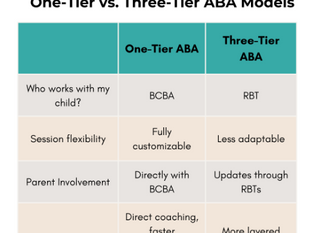
Is ABA Right for My Child? (And What If I’m Still Not Sure?)
Jul 21
7 min read
"Would ABA work for my child?"
Have you been asking yourself that question lately? You aren't alone - many others have too!
Have you just received news that your child has autism, are waiting for services to start or are conducting extensive research into ABA therapy and whether or not it will meet their needs.

But perhaps... you're still uncertain of your decision?
Reluctance towards ABA therapy is understandable: its life-changing potential may benefit some children more than others, yet there's no universal answer for "Should I Do ABA Therapy? There is only what's right for your family and child.
This post will help you gain clarity, confidence and zero pressure in selecting an ABA therapy session.
Because it is okay to still be trying to figure things out.
What ABA Therapy Actually Is (And What It Isn’t)
If you have been researching "ABA therapy," chances are you have come across many definitions--some helpful and some contradictory.
Keep it simple. Applied Behavior Analysis (ABA) is a structured method for teaching children meaningful skills like communication, daily routines, emotional regulation and social play by breaking them down into small steps, teaching them clearly and reinforcing progress over time.
But that is just the technical definition; most parents really want to know:
What does ABA therapy look like in real life?"
Here's the short answer: it depends on the provider.
An effective ABA program usually includes:

Your child and therapist sitting on the floor and building relationships through play.
Transitioning smoothly from one activity to the next is key for managing anxiety-filled transitions without meltdowns.
Positive reinforcement techniques are an effective way of increasing communication, independence, or flexibility in children and youth.
Unfortunately, ABA therapy has sometimes been administered in ways which are rigid or outdated, leading to negative experiences for some families and differing opinions online. That may be why you have heard differing viewpoints.
Let's be clear about this:
ABA isn't just one method. It's more like an arsenal.
And how this toolkit is utilized can make all the difference.
If you’re weighing the ABA therapy pros and cons for autism, you might find this post helpful: ABA Therapy Pros and Cons Every Parent Should Know
You can also read about ABA’s evolution at Autism Speaks, or learn from autistic voices and critiques at NeuroClastic.

🚨Don’t Start ABA🚨
Until You Read This
Not all ABA providers are the same, but most of them sound the same when you’re just starting out.
It's confusing. It’s overwhelming. And unfortunately, many families don’t realize what to look out for until it’s too late.
That’s why we made this free guide:
5 Red Flags Most Parents Miss
Download the guide. No fluff. No fear.
Just straight answers from people who’ve been there.
Who ABA Helps (And What It Looks Like When It Works)
How can You Tell If ABA Therapy Is Appropriate for My Child?
Diagnosis alone doesn't tell the entire story: what matters more is how your child interacts with their world, and where additional assistance might be required.
Here are a few scenarios where ABA could make a real-life impact:

Your child becomes frustrated easily and struggles to express what they need, making transitions a challenging battleground - whether that means bedtime, dressing themselves or turning off an iPad - and you find yourself tiptoeing carefully through each day, hoping to avoid meltdowns and keep things running smoothly.
Your child has only just started talking, or they struggle with back-and-forth interaction; or perhaps someone has mentioned they're "quirky", "strong-willed", or "difficult", leaving you uncertain what is "normal".
Does any of this sound familiar? Don't feel bad. You are certainly not alone.
Parents in the Bay Area frequently report feeling something was off, but were uncertain how best to assist.
Home-based ABA therapy can be an invaluable first step, because it does more than simply address isolated behaviors; rather, it meets your child where they live and builds the basis for lasting development.
What signs indicate ABA is working effectively? They include:
Your child making requests rather than tantrums
Morning or mealtime routines becoming easier
You becoming less reactive and more prepared as a parent
Progress, not perfection, should be the goal. And once that progress starts to manifest in everyday routines, that's how you know that it is working.
What If I’m Still Not Sure?
Even after learning what ABA is and how it works, you might still feel unsure.
That’s normal.
A lot of families we talk to say things like:
“I’m not sure my child needs that much help…”
“I’ve heard some people say ABA is too rigid or outdated…”
“What if we start and it turns out to be the wrong choice?”
These aren’t red flags. They’re signs that you’re doing what good parents do—asking questions, protecting your child, and wanting to make a thoughtful decision.
Let’s walk through a few common concerns:
“I don’t want my child to feel like they’re being trained.”
Totally valid. If ABA is delivered in a cold, robotic way focused only on compliance, it can feel like that.
But when it’s done right? It looks like play, connection, and meaningful progress during everyday routines.
👉🏼 Read more here: ABA Therapy: Pros and Cons Every Parent Should Know
“What if it doesn’t work?”
It’s okay to treat this as a trial, not a lifelong commitment. You can start with a small number of hours. See how your child responds. See how you feel.
Progress takes time, but you don’t have to wait months to know if it’s a good fit. A strong provider will involve you in every step, listen to your concerns, and adjust the plan as you go.
“What if we’re just not ready yet?”
That’s okay too. Some families need time to process the diagnosis before jumping into therapy. Others want to learn a few tools first. That’s where things like parent coaching or short-term consultation can help bridge the gap.
Do Parents Have to Be Involved in ABA? (Short Answer: Yes. Here’s Why.)
You’re allowed to take the next step when you’re ready not before.
“You don’t have to be 100% sure to get started. You just have to be willing to learn and adjust as you go.”
That’s what good therapy is: a conversation, not a contract.
And the best decisions come from curiosity, not pressure.
Want to talk it through? Schedule a free intake call with a BCBA. No pressure, just real answers.
How to Decide on ABA Therapy with Confidence

No need for 100% certainty here - but do deserve an informed, rational way of exploring these decisions.
Parents still unsure about which preschool to select can use our 3-step checklist:
1. Establish your goals first--not someone else's agenda
Ask yourself this: "In three months' time, what do I want my home life to feel like?"
Are You Wanting Fewer Meltdowns during Transitions, Smoother Mornings and Bedtimes, etc.?...
Write out your goals. They matter more than any clinical term and will enable you to ask better questions during intake or consult calls.
2. Review how therapy plans correspond with these goals
A good provider should be able to show you how your child's ABA plan targets what matters most to you.
If your plan consists of compliance-focused behaviors that don't pertain to real life, that could be a red flag.
If you want to know what a plan aligned with family needs looks like, read this next:
3. Check in with your gut
After a conversation with a provider, ask yourself:
“Do I feel more hopeful? More clear? Or more overwhelmed?”
The right fit won’t leave you spinning.
It won’t load you up with guilt, urgency, or confusing terms.
It’ll feel collaborative. Relational. Like something that could actually work.
You’re allowed to pause.
You’re allowed to ask more questions.
You’re allowed to walk away and come back later.
You’re making a big decision and that deserves time and clarity.
You Don’t Have to Know Everything. You Just Have to Take the First Step.
There’s no perfect moment.

No checklist that guarantees you’re doing this “right.”
But the fact that you’re here reading, questioning, caring tells me something really important:
You’re already doing the hard part.
You’re showing up. You’re looking for support.
And that’s more than enough to start from.
You don’t need to commit to 30 hours a week.
You don’t need to have your child’s future figured out.
You just need one small step forward—one conversation, one question, one moment of clarity.
That’s how this starts for most families.
Not with certainty. With curiosity.
Not with a master plan. With one choice that leads to the next.
If you’re still unsure, take some time. Bookmark this. Come back to it.
Or, if you’re ready to learn more, you can start by asking the questions we shared above.
And no matter where you are in the process exploring, hesitating, or just beginning know this:
You’re not alone.
You’re not behind.
And you’re not the only one trying to make the best call for your child.
You’re right where you’re supposed to be.
Is ABA Therapy Right for My Child? FAQs Parents Ask Most
Is ABA therapy right for every child with autism?
Not always. ABA can be incredibly helpful for many children, especially when it’s personalized and play-based. But the fit depends on your child’s needs, your goals, and how the therapy is delivered.
What if I’m not sure whether to start ABA therapy?
You don’t have to be 100% sure. Start with a conversation, set a few small goals, and treat it like a partnership. You can always adjust along the way.
Is ABA therapy good or bad?
It depends on how it’s done. ABA is a tool. When used with respect, flexibility, and care, it can be life-changing. When done poorly, it can be harmful. That’s why choosing the right provider matters. You can also read both positive and critical perspectives, like this article from Child Mind Institute.
How do I decide if ABA therapy is the right fit for my child?
Focus on your goals, ask how therapy aligns with those goals, and pay attention to how you feel during conversations with providers. You should feel heard and supported—not pressured.
Can I do ABA therapy part-time or without a full diagnosis?
In many cases, yes. Some families benefit from part-time hours or parent coaching, even before a formal diagnosis. It depends on the provider and your child’s needs.
Related Posts






